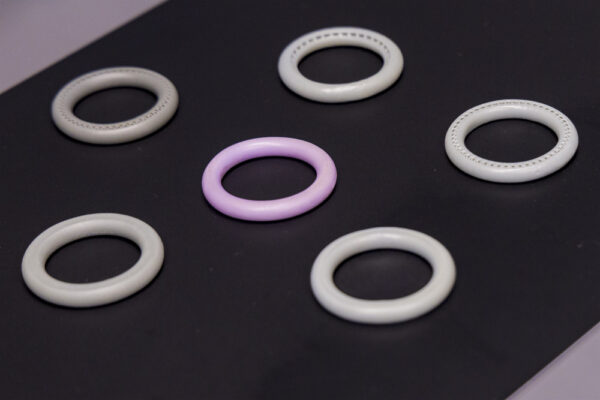At 3 years old, Rahima Benhabbour knew she wanted to be a scientist. She remembers examining her father’s rock collection and would listen intently as he shared each stone’s story, gleaning as much information as she could. He was a geologist, and she dreamed of following in his footsteps.
But when a civil war broke out in 1991 in her home country of Algeria, she knew field research would no longer be safe. Luckily, her passion and curiosity were recognized by her high school science teacher, who helped her fall in love with chemistry. She could still pursue the awe of discovery from the safety of a lab bench.
“It just came naturally to me,” she recounts. “Sounds geeky, but I liked mixing things in the lab. When you create a reaction, you know you’re actually making things happen: connecting two things or making a new molecule or inventing something completely new, which is fascinating.”
While her newfound love for the lab cemented her path as a scientist, it wasn’t an easy one. She decided to pursue a bachelor’s degree in engineering at the Algerian Institute of Petroleum, where she was one of five women in her class of 300 students.
“There were only a handful of us, which made us special, but it was hard in many ways,” she reflects.
But Benhabbour saw things others missed. She was struck by the struggles women faced in getting access to proper health care — and believed science could shift this narrative.
Impact Report

HIV remains a persistent problem in the U.S. with 31,800 infections in 2022, according to the Centers for Disease Control and Prevention. Rahima Benhabbour’s research helps prevent and slow infection rates.
![]()
This research is funded by grants from the National Institutes of Health, the largest funder of U.S. clinical trials. Federal funding supports vital research, advancing treatments for the people of N.C. and beyond.
Identifying an issue
In 2009, Benhabbour began researching HIV protections and women’s health as a postdoctoral researcher at the UNC Eshelman School of Pharmacy. She discovered that although HIV prevention methods existed, very few were designed to fit the needs of the most critical population: women in Sub-Saharan Africa. The options available, like daily pills, were burdensome and often not discreet enough, especially considering the stigma around HIV.
The shame associated with contracting HIV in Sub-Saharan Africa is rooted in social and cultural taboos, leading to discrimination and ostracization. Women with HIV are often reluctant to seek help, further complicating efforts to combat the epidemic in the region.
As Benhabbour continued her work as a postdoctoral researcher and then a faculty member at UNC Chapel-Hill, her eyes were opened to the broader lack of research and funding in women’s health.
“There are so many gaps,” she says. “Women were not even involved in clinical trials until 30 years ago.”
But what really shocked her was the vulnerability of women in various regions. Many contract HIV without knowing their partners are infected and don’t have the tools to protect themselves. And because the virus can be transmitted through gestation and breast milk, their children are also exposed.
Carolina scientists have been developing HIV treatments and prevention strategies since the early 1980s. Benhabbour is the first to use this research to develop and engineer a product that would help the women affected.
Incubating ideas
Benhabbour wanted to create an option to prevent HIV and unintended pregnancy in Sub-Saharan Africa, where women and girls account for 62% of all new HIV infections in the region.
She carefully considered every aspect of product development. For instance, the packaging had to be discreet, as many women fear telling their partners about contraceptive use, and the method of administration needed to address privacy concerns to ensure comfort and confidentiality.
“It’s one thing to develop products for U.S. customers, and then it’s another to develop them for a society where there are socioeconomic and cultural hurdles that are completely non-existent for us,” she remarks.
Even after gaining a deep understanding of this community, Benhabbour still lacked the technology to bring her vision to life.
But in 2015, while watching a TED Talk by one of her mentors and former Carolina researcher Joe DeSimone, inspiration struck. On stage, DeSimone demonstrated the 3D printing technology he developed that could create a complex structure with extreme precision. Benhabbour knew she could utilize this innovative tool for her product.
“Watching that TED Talk, all I could think of was, Whoa, what if we could actually make a vaginal ring that could have those intricate features?” she says.
She emailed DeSimone at midnight with her idea — and he responded immediately.
Engineering solutions
One year later, after a series of phone calls and meetings, Benhabbour patented a 3D-printed intravaginal ring. It’s designed to release antiretroviral drugs alone or in combination with contraceptive hormones for prevention of HIV and unintended pregnancy over a period of 28-90 days. It uses a method created by DeSimone’s company Carbon, Inc. called continuous liquid interface production, a process that creates a more comfortable product for users while speeding up the manufacturing process and making it scalable for commercialization.
“We want a smooth product that would be very comfortable for women to insert and leave in for a long time,” she says.
The 3D printing process has also allowed Benhabbour’s team to increase the surface area of the ring with unique patterns in the material that give it a beeswax-like look. This design releases the entire treatment dose that they incorporate into the ring.
“We’re not wasting any drug,” she explains. “Having those intricate features and designs allows us the unique ability to control how the drug releases from the ring and for how long.”
Now that they’ve developed the technology, Benhabbour’s team is beginning to use focus groups in Sub-Saharan Africa to determine the best color, design, size, and feel for their target population. The next step will be getting approval from the FDA to begin clinical trials so that Benhabbour can get these rings in the hands of the women who need them.
Creating accessible products
HIV prevention isn’t the only women’s health issue Benhabbour is addressing. She founded her startup company AnelleO Inc. in 2016 to use the ring technology for infertility treatments. Using the same 3D printing method, they can load the intravaginal ring with progesterone to promote fertility, releasing it steadily for up to 28 days while it’s inserted.
This research has also expanded beyond the vaginal ring. Her lab is now developing a long-acting, single injection to prevent HIV and unintended pregnancy for six months. This work has garnered attention and grants from organizations like the National Institute for Allergy and Infectious Diseases and the U.S. Agency for International Development, accelerating the treatment to human clinical trials.
“Our intention is to get it to lower- and middle-income countries, and I think because we’re in a public institution, the main drive for developing these technologies is public health impact and not for-profit return on investment” she says.
Benhabbour’s career has always been driven by a single philosophy: impact. For her, science is not just about innovation for its own sake. As a woman from Africa, she wants to give back to where she comes from and create real-world solutions for the women that need them most.
“Women’s health is such an underserved area of research,” she says. “If I can make a tiny dent, I would call myself fulfilled in terms of career. The more we can fill those gaps, the more we can get people to see that women’s health is everybody’s health.”



